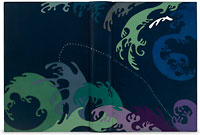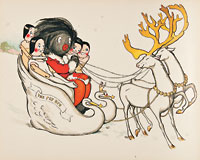Personality Abounds: An American Adventuress, A Sulking Painter, A Poetic Bad Boy, and a Fashion-Forward King
The Whale and the Waves
Moby Dick, Swanns New York on November 10, $13,400
Limited to just 265 copies, the version of Herman Melville’s Moby Dick issued in 1979 by San Francisco’s Arion Press is a famously handsome work, distinguished by typography, overall design, and Barry Moser’s illustrations and engraving. Prices have been edging towards the five-figure level for some years, and in 2008, a copy sold in San Francisco by PBA Galleries reached $9,600.
Last month, that record was broken and the five-figure mark passed by a copy that sported a custom binding by renowned designer-binder, Kerstin Tini Miura. In deep blue crushed morocco, it is decorated with stylized and multi-colored wave forms and has the author’s name, book title, etc., picked out in tiny silver letters that run from the rear cover, across the spine to the front cover. With endpapers of pale blue sheep, a protective chemise in navy morocco with silver lettering, and marbled blue paper, this was a special copy, but not the only Arion edition of Melville’s masterpiece on which the binder has exercised her art.
In 1998, Swanns sold another in which abstract waves were joined by the tail of a diving whale that spread across the covers and spine. Bound in white crushed morocco, that one sold for $7,475.
A Present from Waldo
Essays, Skinners Boston on November 15, $48,770
It wasn’t the most expensive thing in the sale–that was a browned and stained, but very rare letter of 1581 in Martin Luther’s hand that reached $106,650–but a copy of Ralph Waldo Emerson’s Essays certainly performed much better than expected.
A first of the first series of essays, published by James Monroe of Boston in 1841, it is a little spotted, and the original gilt-lettered and brown cloth binding is chipped, bumped, and split at the hinges. On the face of it, a rather unassuming little volume, but this is a presentation copy. Inscribed “William Emerson from his brother Waldo,” it entered the sale catalogue with a meagre estimate of $800-1,200, but given that a copy inscribed to Amos Bronson Alcott (educationalist, writer, and of course, Louisa May’s father) had sold in London in 1998 for around $28,000 some ten years ago, this always seemed an unlikely outcome.
A Merry Christmas, One and All
The Golliwogg’s Christmas, Bloomsbury Auctions London on October 29, $1,200
I did my best to add a little festive fun in this month’s selection, but all I could find was The Golliwogg’s Christmas of 1907. These once popular children’s books are now viewed by many with disdain; nevertheless, they remain very collectable, and it may be worth noting what caused offence to some readers when the first title in this series, The Adventures of Two Dutch Dolls and a Golliwogg, was published 1895. It was not any racist implication (the Golliwogg is a based on black minstrel doll), but the fact that the Dutch dolls lived, unchaperoned, with the Golliwogg!
Born in the United States to English parents, Florence Upton moved to England when she was 20 and stayed. Her mother, Bertha, returned to America before that first Golliwogg book was issued, but she continued to send the rhymed stories for her daughter to illustrate.
The illustration reproduced here shows the hero and his ‘penny-wooden’ Dutch Doll companions squashed into a swan-headed sleigh called ‘The Fly Byr.’ In this story, the Golliwogg and his chums, Sarah Jane, Meg, Weg, and Peggy, go shopping for trinkets to put in their stockings, wrap presents, chop down a tree to decorate, make a Christmas pudding, hang a Christmas wreath, and so forth. Concerned that Santa may not actually be real, Golly himself dresses up as Santa to come down the chimney in the time-honored tradition, but he ruins the tree in the process. Finally, as he and the dolls go for a sleigh ride, the real Santa arrives and leaves presents for the dolls—but nothing for Golliwogg!








 Ian McKay’s weekly column in Antiques Trade Gazette has been running for more than 30 years.
Ian McKay’s weekly column in Antiques Trade Gazette has been running for more than 30 years.

